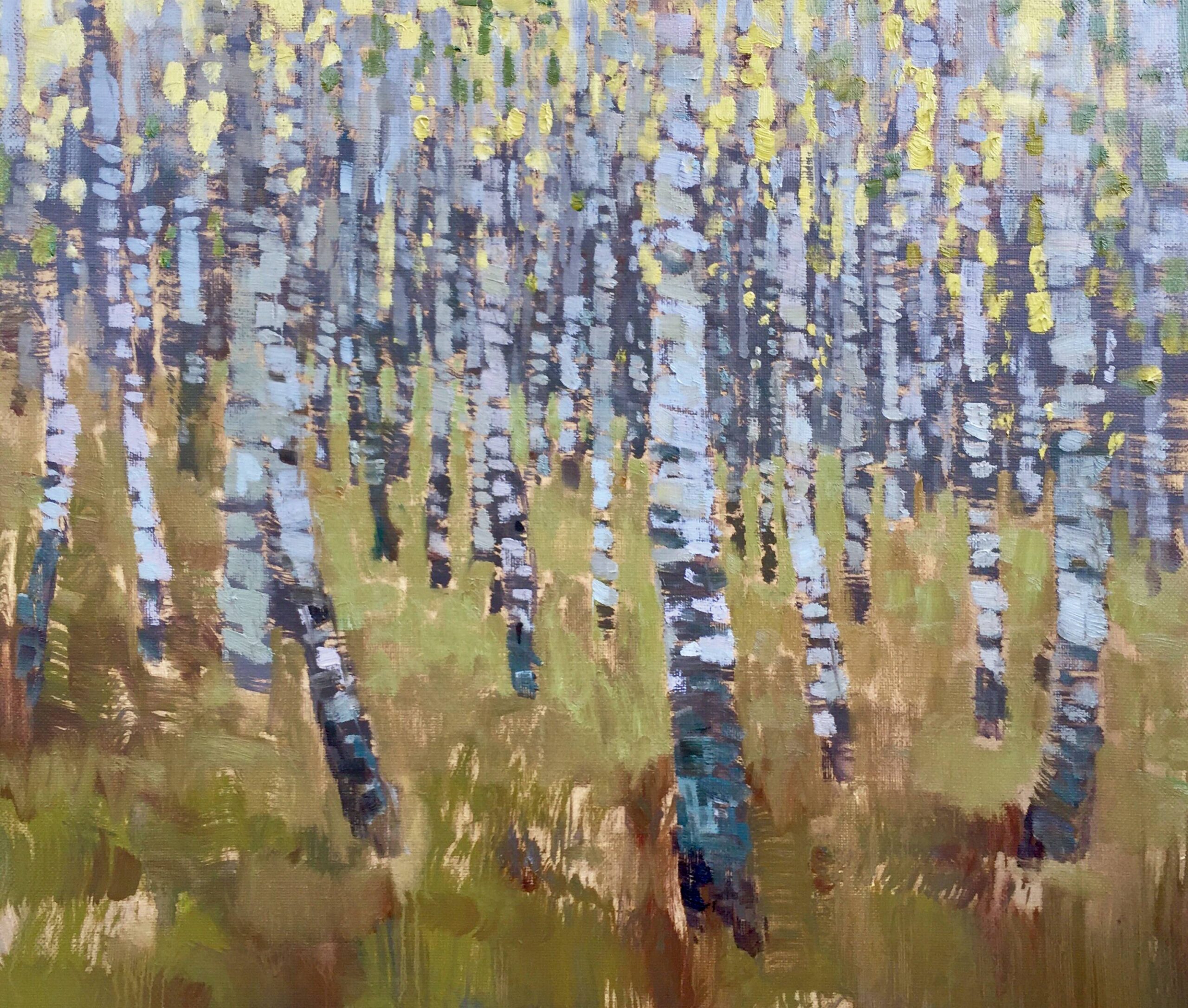Click here to see this email on the web
|
 |
Thursday, June 22nd, 2023
|
|
15 Ideas for a Painting
|
By Aimee Erickson
|
Share this article:    
|
 |
Aimee's setup for a plein air painting of birch trees, using broad brushstrokes
|
In “Plein Air Techniques for Artists: Principles and Methods for Painting in Natural Light,” award-winning artist and respected workshop instructor Aimee Erickson demystifies how to capture a variety of light effects and guides you in strengthening your plein air skills through practice. The following is a brief excerpt:
What To Do If You Don’t Have An Idea
Try doing less. Limiting some aspect of your scope has the effect of sparking creativity. You can introduce physical limitations, limits to your palette or stylistic approach, or what tools you use.
• Paint with your non-dominant hand.
• Paint with your back to the subject and limit the number of times you can turn to look at it.
• Set a time limit. Try twenty minutes, or less, and reduce the number of decisions you make to fit.
• Work small. On a big canvas, mark off a small box in the corner and do a mini painting.
• Use a single big brush on a small canvas.
• Do the entire painting with a palette knife—or a credit card.
• Work in black and white only.
• Choose a limited palette that has no relation to your subject.
• Limit yourself to four colors only.
• Find something very small to paint—a single well-lit object or a color relationship.
• Make thumbnails and design sketches instead of something more
ambitious.
• Paint a familiar subject.
• Make an abstract color study.
• Make vertical brushstrokes only, or horizontal brushstrokes only, or all diagonal brushstrokes.
• Use a toned canvas and keep all your brushstrokes from touching each other; then, make an exception.
|
— advertisement —
|
 |
Technique: Using Broad Brushstrokes
The painting below demonstrates the efficient use of a very broad brush. I had very little time before dinner, but I’d been passing these birch trees daily and the moment had come.
I had with me a 6-inch (15.2-cm) wide hardware-store paintbrush with soft bristles. Looking at the complex patterning on the tree trunks, I figured I could use that wide brush, in a horizontal stroke, to put in all the darks at once, as a broken pattern, maybe even with a single stripey brushstroke, and then add grass and white birch bark to make an illusion of different-sized trees. It worked!
I tend to not be a detail painter, and all those dark markings on the birch trunks would be mighty discouraging if I had to paint them with a rigger.
|
 |
Aimee Erickson, “Birches of Volzhkiy Priboy,” oil on linen, 15 3/4 x 23 2/3 in.
|
|
|
|
Looking ahead, register for Pastel Live and learn from the world’s top & most accomplished pastel painters! Learn about the next one at PastelLive.com now.
|
— advertisement —
|
 |
The Legacy of J.M.W. Turner
|
By Kelly Kane
|
 |
J.M.W. Turner, “Venice: Looking Across the Lagoon at Sunset,” 1840, watercolor on paper. Tate: Accepted by the nation as part of the Turner Bequest 1856 © Tate, London 2018
|
Watercolor played a critical role in defining J.M.W. Turner’s deeply personal style. The artist’s vast legacy comprises more than 30,000 works on paper, 300 oil paintings, and 280 sketchbooks, known as the “Turner Bequest,” which was donated to Great Britain after the artist’s death in 1851 and mostly conserved at Tate Britain. The bequest includes the entire body of works housed in the artist’s personal studio and produced over the years for his “own pleasure,” to cite the words used by the critic John Ruskin.
Turner was a lifelong watercolorist and fundamentally shaped what was understood to be possible within the medium during his lifetime and after. An inveterate traveler, Turner rarely left home without a rolled-up, loose-bound sketchbook, pencils, and a small traveling case of watercolors. These memories of journeys, emotions, and fragments of landscapes seen during his long stays abroad illustrate the development of Turner’s stylistic language focused on experimenting with the expressive potential of light and color.
|
 |
J .M. W. Turner, “Scarborough,” c.1825, Watercolor and graphite on paper. Tate: Accepted by the nation as part of the Turner Bequest 1856 © Tate, London 2018
|
The radical developments in Turner’s style anticipated trends of the late 19th century. From his love of seaside towns to his interest in depicting atmospheric English and Alpine landscapes, and his detailed study of domestic interiors and architectural reliefs, the artist devoted himself tirelessly to experimentation, particularly in watercolors, with a compositional and stylistic freedom and an innovative and surprising use of colors that led his peers to believe that Turner “appeared to paint with his eyes and nose as well as his hand.”
Deemed to be an extraordinary artist ever since his own time, Turner has had a profound and continuing influence on artists that continues to this day.
|
— advertisement —
|
 |
— advertisement —
|
 |
|
|
|
|
|
Plein Air Today is committed to protecting and respecting your privacy. We do not rent or share your email address. By submitting your email address, you consent to Streamline Publishing delivering regular email issues and advertisements. To end your Plein Air Today e-mail subscription and associated external offers, unsubscribe here. To learn more about Streamline Publishing events, products, and offerings visit StreamlinePublishing.com
Copyright 2023 Streamline Publishing, Inc. All rights reserved.
PleinAir Today® is a registered trademark of Streamline Publishing, Inc. |
|
|
|
|